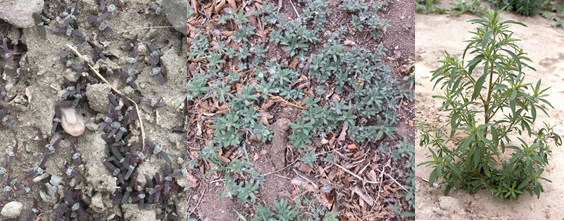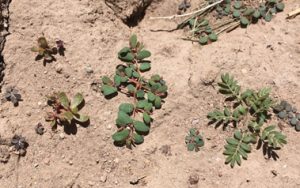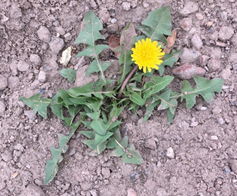Written by Kristina Langan, Colorado Master Gardener, 2020
Spring is here, and all the browns and grays are turning to green again. But with the plants we like come the plants we don’t: the plants we call “weeds.” To help you make this year the year that you keep pace with their rapid growth, here are some weed management tips to deal with the earliest of our local usual suspects.
First, some general advice.
There are many techniques to control weeds that don’t require the use of herbicides. For optimal management, simply pulling weeds is often not enough. As the saying goes, nature abhors a vacuum. If there is nothing planted in an area, weeds will fill the space. If you have limited time and energy for weeding, preventing weed growth to begin with is the way to go.
- You can reduce the amount of weed seed in your soil by “solarizing.” This involves laying down plastic to heat the soil. Some weed seed will germinate and then die, others will simply die from the heat created by the plastic. It must be done right though, so be sure and read up on it.
- Another non-chemical weed control technique is…chickens!! They eat seeds, and seedlings, and insect pests and…well, just about anything, so you’ll have to keep an eye out they don’t destroy your favored plants.
- Using favored plants as ground cover is a solution; your lawn, if you have one, is a sturdy ground cover that, when properly cared, for will prevent weed growth. Try choosing a native grass like buffalo grass or blue grama for a water-wise lawn.
- Mulching heavily with four to six inches of wood chips is one of the best solutions. Laying the wood chips on top of layers of cardboard or newsprint makes it more effective, but don’t skimp on the depth of the mulch!
- The same goes for rock and gravel mulch: you must use a thick layer. Larger gravel has pockets where water, debris and seeds collect creating a perfect environment for germination, so choose instead a smaller gravel size like pea gravel. Consider foregoing weed barrier. It does little to prevent weeds from growing up from underneath and can cause other problems.
- If you really have no time to deal with weeds, hardscaping with bricks or pavers is the best solution.
If you do use herbicides, read the label and follow the instructions. Using more than the label specifies is illegal and can be dangerous to you and the environment. Using too little won’t work and can cause your weeds to develop resistance. The label can also tell you if the herbicide is appropriate for the plant you are trying to kill and the best phase of growth for application. For example, a pre-emergent like the mecoprop in your average “weed&feed” mix prevents germinated seeds from breaking through the soil, so it must be applied prior to germination, while post-emergents like glyphosate and 2,4-D work on adult plants and can be applied any time. [Special note: Be aware if you choose to try “natural” herbicides or home remedies: Natural does not mean safe, for you and/or the environment. Remember the old adage “the poison is in the dosage.” A high enough concentration of a “natural” ingredient will also be harmful. Be sure to research your method thoroughly and compare to the efficacy and dangers of lab-made chemicals.]
Annuals
Knowing the species you are dealing with can go a long way in your weed management strategy, in particular knowing your annuals from your perennials. Most of the weeds that come in early spring are annuals. They are going to die off on their own, so it’s ok if you don’t get the roots when pulling. Their strategy is to hit early, and hit hard, thus avoiding competition. As long as you don’t let them go to seed, they can be good helpers: they will provide competition for late-comers, and what you do pull or mow can be used as compost, “green manure,” or as mulch. If you manage them right, you will never need to use herbicide on them. Treating annuals that have already gone to seed with herbicide is, in fact, a complete waste of money.
Tansy mustard (Descurainia pinata) (left two photos) and Musk or Blue mustard (Chorispora tenella) (right two photos)

The first of the spring weeds to come along around here are the mustards: tansy mustard (Descurainia pinata) and musk or blue mustard (Chorispora tenella). They both emerge initially in a rosette form; Musk mustard rosettes resemble dandelion rosettes, except for their rounded leaf tips. Tansy mustard is the taller, with yellow flowers in the classic four-petaled “propeller” shape of the Brassica family. Musk or blue mustard lives up to both of its names: you may see this weed spreading across entire fields, giving them a purplish tinge. If you do, you are sure to smell it: a heavy and sweet perfume with the sour smell of spoiled cabbage lurking beneath. It’s off-putting to many, but if you grew up in Colorado, you might love the smell just out of nostalgia. You certainly will recognize it. Because these early bloomers are some of the only food sources for bees, consider leaving these to flower and pulling or hoeing before they set seed. They are easy to pull and if they do go to seed, there are far worse species to have in your seed bank.
Kochia weed (Kochia scoparia aka Bassia scoparia)

The next to come is a thorn in the side of many a landlord: the kochia weed (Kochia scoparia aka Bassia scoparia). Its tiny purplish-green seedlings are already sprouting up, and if you turn away for a week, they will have turned into a fuzzy, grayish green groundcover. If you turn away for another week, it will start to grow up tall, and this is the point where a smart landlord will save themselves a lot of work by showing up to their properties and mowing. Mowed kochia helps to crowd out other weeds, and, as long as it isn’t flowering, the clippings make good mulch or green manure. (Be careful though: its tiny green flowers are are hard to spot.) But miss another week or two, it will be three feet tall, and its half inch diameter stems will render a weed whacker useless. By the end of the summer, it will be eight feet tall and have stems an inch and a half to two inches in diameter. So, catch it early, and let it be your friend. If you don’t, be advised that it has some herbicide resistance. You will be better off pulling it if you can or trimming it back if you can’t, and then letting it die on its own.
Purslane (Portulaca oleracea) (left), the spurges [Spotted spurge (Chamaesyce maculata) or Prostrate spurge (Euphorbia supina)] (center), and Puncturevine (Tribulus terrestris)(left)

Mowing isn’t going to help with these three low-growing annuals. The worst of them by far is puncturevine, also known as “goathead” weed. The spines on its seed-casings are no joke. They are painful to humans and animals; they puncture bike tires with ease. Letting purslane or spurge take over can help crowd it out a little bit, but you have to keep your eye on them; puncturevine will grow up amongst both of these, and they are fairly similar-looking, so it’s easy to miss. Hoeing all of these when tiny is a good strategy: turning them back into the soil is good “green manure.” If you miss their tiny stage, focus on finding the center root of these wide-spreaders. Often what looks like a very large patch has only a few actual roots to pull, and remember, thorough root removal is not going to matter with an annual, as those roots will die over the winter. Purslane can re-root itself from pulled fragments, so it’s best to remove them to the trash. The most important thing for all of these is to prevent puncturevine from going to seed, preferably getting it taken care of before it even flowers. If you aren’t going to have the time for weeding, this is one annual that justifies herbicide use. A pre-emergent like trifluralin is a good choice, but you must apply it early, before the seeds begin to germinate, and don’t apply in areas where you will be laying seed for other plants, for example, if you are re-seeding your lawn. Here in Pueblo, early means mid-March, so this year, if you end up needing to go the herbicide route, you’ll have to use glyphosate or 2,4-D. You may have heard there’s biocontrol for puncturevine: a seed feeding weevil known as Microlarinus lareynii, but this can be hard to get and is more for large land areas such as used in agriculture.
Cheatgrass aka Downy brome (Bromus tectorum)

This winter annual tends to just flatten instead of getting clipped off, and it will still flower and seed. Cheatgrass can also go to seed when still very short. Although it has a reddish cast when ripe, any green seeds left on the ground can also mature and sprout. If you can’t put down mulch or other ground covering that prevent it from sprouting at all, pulling and hoeing is really the best strategy. Always hoe as little and as shallowly as possible as deep hoeing and tilling can bring up new weed seeds where it can germinate. Do try to get the roots with this annual; they can send up new shoots rapidly.
Perennials
Unlike annuals, management of perennial weeds requires you to get to the roots. These two common perennial weeds are probably the toughest characters in your garden.
Dandelion (Taraxacum officinale) and Field bindweed aka wild morning glory (Convolvulus arvensis)


Dandelions are known as “simple perennials”: while the roots live over the winter allowing an individual plant to come up year after year, it must spread by seed. Bindweed is an example of a “creeping perennial.” Although bindweed spreads by seed, large patches can also form by root growth alone. Systemic herbicides like glyphosate and 2,4-D are the best choice for both types of perennials because they move throughout the plant to kill the roots. In a lawn, use 2,4-D because it will kill broadleaf species without damaging grassy plants.
If not using a chemical herbicide, dandelions are best managed by heavy mulching combined with pulling the plants before they go to seed. Dig deep with a special dandelion puller or spade to get as much of the long tap root as you can.
Bindweed on the other hand has an extensive root system and because you will have to till or hoe deep to get at it, using a rototiller is preferred. Considering that this process can dig up more weed seed, a chemical herbicide may be your best bet for getting rid of this tenacious plant. Alternatively, you will need to pull up green sprigs as soon as they appear in order to eventually starve the root system. You can also try repeated smothering with layers of cardboard to block sunlight. Watch the surrounding area because bindweed will spread until it can emerge in an area where light is available. Look carefully at your suspected bindweed. Correct plant ID in this case can save you a lot of work because a common look-alike for bindweed is the annual wild buckwheat aka black bindweed (Fallopia convolvulus or Polygonum convolvulus). This species is easy to pull by hand and you need not do extensive tilling to get the roots.

Happy weeding!
To learn more, check out these links:
INTEGRATED PEST MANAGEMENT FOR WEEDS
CSU Extension GardenNotes #351
https://cmg.extension.colostate.edu/volunteer-information/cmg-gardennotes-class-handouts/
WEED ID with control advice
https://webdoc.agsci.colostate.edu/ipm/WeedWackersFinal7.18.13.pdf
(best control advice for home gardens)
https://plants.usda.gov/core/profile?symbol=BASC5
(extensive database; click on “plant guide” links for greater detail; control advice is mostly for agriculture not home gardens)
http://ipm.ucanr.edu/PMG/PESTNOTES/pn7441.html & http://ipm.ucanr.edu/PMG/menu.homegarden.html
(California, but applicable to Colorado)
https://ag.colorado.gov/conservation/noxious-weeds/species-id#c
(download the fact sheet on an individual weed’s page; control advice is mostly for agriculture not home gardens)
WEED ID by state with Preen products suggestions
https://www.preen.com/weeds#!co
HERBICIDES video from Oregon State University Extension
Weed Management in the Garden & Landscape: Understanding Herbicides
https://www.youtube.com/watch?v=eNb76Y22Wgoinfo
NATURAL HERBICIDES info
https://cmg.extension.colostate.edu/volunteer-information/cmg-gardennotes-class-handouts/#weeds
(Click on Weed Management (topic 350) and then on Natural Herbicides for Landscape Weed Management to download pdf)


